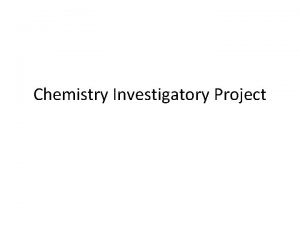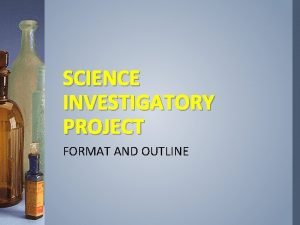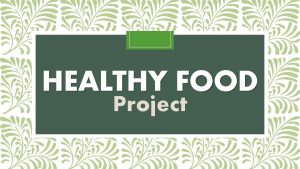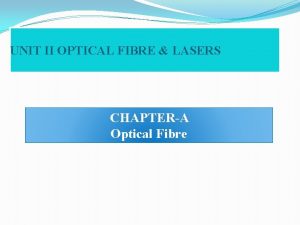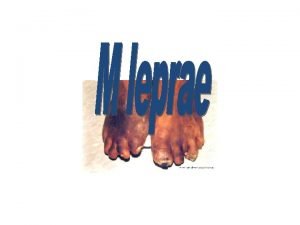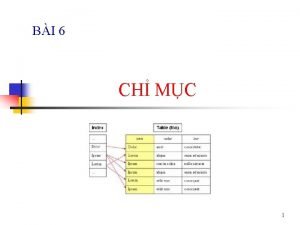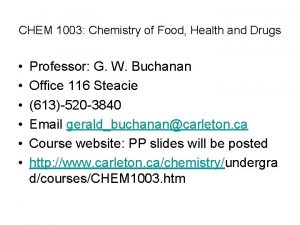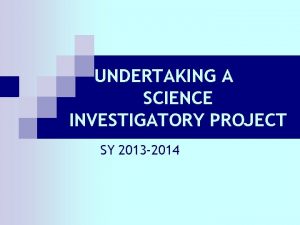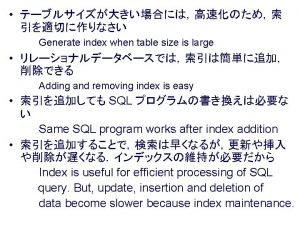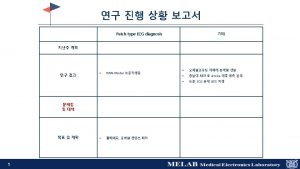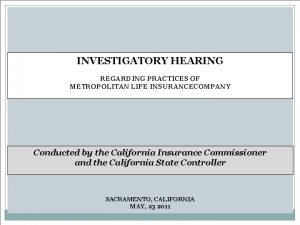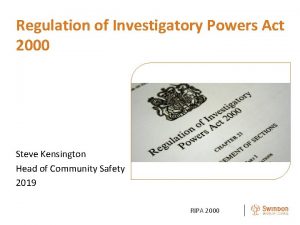Chemistry Investigatory Project DETECTION OF FOOD AULTERATION index


















- Slides: 18

Chemistry Investigatory Project

DETECTION OF FOOD AULTERATION

index 1. Experiment-1 2. Experiment-2 3. Experiment-3 4. Observation 5. Conclusion 6. Precaution

EXPERIMENT-1 AIM To detect the presence of adulterants In fat , oil butter. Apparatus Required Test tube , acetic anhydride conc. h 2 so 4, acetic acid, conc. HNo 3

Procedure Common adulterants present in ghee and oil are paraffin wax, hydrocarbon, dyes andargemon oil. These are detected as follows : 1. Adulteration of paraffin wax hydrocarbon in vegetable ghee heat small amount of vegetable ghee with acetic anhydride. Droplets of oil floating on the Surface of unused acetic anhydride indicates the presence of wax or hydrocarbons.

2. Adulteration of dyes in fat heat 1 ml of fat with a Mixture of 1 ml of conc. Sulphuric acid and 4 ml of acetic acid. Appearance of pink or red colour indicates presence of in fat. 3. Aduteration of argemone oil in edible oils to small amount of oil in a test-tube, add few drops of conc. HNo 3 and shake. Appearance of red colour in The acid layer indicates presence of argemone oil.

Experiment-2 Aim To detect the presence of adulteration in sugar Apparatus required Test-tubes, dil. HCL. Procedure: Sugar in usually contaminated with washing soda and insoluble substance which are detected as follows:

1. Adulteration of various insoluble Substances in sugar takes small amount of sugar in a test-tube and shake it with little water. Pure sugar dissolves in water But insoluble impurities do not dissolve. 2. Aduteration of chalk powder, washing soda in sugar To small amount of sugar in a test-tube, add few drops of HCL. Brisk effervescence of CO 2 shows the presence of chalk powder or washing soda in the given sample of sugar.

Aim Experiment-3 To detect the presence of adulterants in sample of of chilli powder , Turmeric powder and pepper. Apparatus required: Test-tubes, conc. HCl, dil. HNO 3, KI solution. Procedure: Common adulterants present in chilli powder, Turmeric powder and pepper or red coloured Lead salts, yellow lead salts and dried papaya seeds Respectively. They are detected as follows:

1. Adulteration of red lead salts in chilli powder, add dil. HNO 3. Filter the dilsolution and add two drop of potassium iodide dilsolution and add 2 drops of Potassium iodine solution to the filtrate. yellow ppt. Indicates the presence of lead salt in chilli powder. 2. Adulteration of yellow lead salts to turmeric powder a sample of turmeric powder conc. HCl. Appearance of magenta colour shows the presence of yellow oxides of lead in turmeric powder.

3. Adulteration of brick powder in red chilli powder Add small amount of given red chilli powder in beaker Containing water. Brick powder settle at the bottom While pure chilli powder floats over water. 4. Adulteration of dried papaya seeds in pepper to a beaker containing water and stir with a glass rod. Dried papaya seeds being lighter float over water While pure pepper settle at bottom

EXPT. NO. EXPERIMENT PROCEDURE OBSERVATION 1. Adulteration of paraffin Wax and Hydrocarbon In vegetable Ghee. Heat small Amount of vegetable Ghee with Acetic Anhydride Droplets of oil Floating on The surface of Unused acetic Anhydride indicate the Presence of Wax or Hydrocarbon. Appearance of oil floating On the surface. 2. Adulteration Of dyes in fat. Heat 1 m. L of fat with a Appearance of mixture of 1 m. L of conc. pink colour. H 2 SO 4 and 4 m. L of acetic acid.

EXPT. NO. EXPERIMENT PROCEDUR E OBSERVATION 3. Adulteration of argemone oil in edible oils. To small amount of oil in a test tube , add few drops of conc. HNO 3 and shake. No red colour observed. 4. Adulteration of various insoluble substances in sugar. Take small amount of sugar in test tube and shake with little water. Pure sugar dissolves in water but insoluble impurities do not dissolve.

EXPT. NO. EXPERIMENT PROCEDURE OBSERVATION 5. Adulteration of chalk powder , washing soda in sugar. To small amount sugar in a test tube , add a few drops of dil. HCl No brisk effervescence observed. 6. Adulteration of yellow lead salts to turmeric powder. To sample of Appearance of turmeric powder , magenta colour. add conc. HCl 7. Adulteration of red lead salts in chilli powder. To sample of chilli No yellow powder , add dil. precipitate. HNO 3. filter the solution and add 2 drops KI solution to the filtrate.

EXPT. NO. EXPERIMENT PROCEDURE OBSERAVATIO N 8. Adulteration of brick Add small powder in chilli amount of powder. given red chilli powder in a beaker containing water. Brick powder settles at the bottom while pure chilli powder floats over water. 9. Adulteration of dried Add small papaya seeds in amount of pepper. sample of pepper to beaker containing water and stir with a glass rod. Dried papaya seeds being lighter float over water while pure pepper settles at bottom.

Result : - The required analysis for adulterants in food Stuffs has been made.

CONCLUSION Selection of wholesome and non-adulterated food is essential for daily life to make sure that such foods do not cause any health hazard. It is not possible to ensure wholesome food only on visual examination when the toxic contaminates are present in ppm level. However , visual examination of the food before purchase make sure to ensure absents inserts, visual fungus , foreign matters , etc. therefore , due care taken by the consumer at the time of purchase of food after thoroughly examining can be of great help. Seconly , label declaration on nutritional value. It also helps in taking a freshness of the food and the period of best before use. The consumer should avoid taking food from an unhygienic place and food being prepared under unhygienic conditions. Such types of food may cause various diseases. Consumption of cut fruits being sold in unhygienic conditions should be avoided. It is always better buy certified food from reputed shops.

Precautions : - By taking a few precautions , we can escape from consuming adulterated product 1. Take only packed items of well-known companies. 2. Buy items from reliable retail shops and recognized outlets. 3. Check the ISI mark or Agmark. 4. Buy products of only air tight popular brands. 5. Avoid craziness for artificially coloured sweets and buy only from reputed shops. 6. Do not buys sweets or snacks kept in open. 7. Avoid buying things from street side vendors.
 Adulteration chemistry project
Adulteration chemistry project Format of investigatory project
Format of investigatory project Unit 2 food food food
Unit 2 food food food Eltonian pyramid
Eltonian pyramid Junk food vs healthy food project
Junk food vs healthy food project Optical fibre
Optical fibre Primary index is dense or sparse
Primary index is dense or sparse Morphological index and bacteriological index
Morphological index and bacteriological index Physical quality of life index and human development index
Physical quality of life index and human development index Fibers
Fibers Simpson diversity index
Simpson diversity index Liquid limit of soil formula
Liquid limit of soil formula Clustered index và non clustered index
Clustered index và non clustered index Ib organic chemistry functional groups
Ib organic chemistry functional groups Organic vs inorganic chemistry
Organic vs inorganic chemistry Index pattern for project
Index pattern for project How to calculate profitability index
How to calculate profitability index Chemistry food and drugs
Chemistry food and drugs Chapter 4 basic food chemistry the nature of matter
Chapter 4 basic food chemistry the nature of matter
